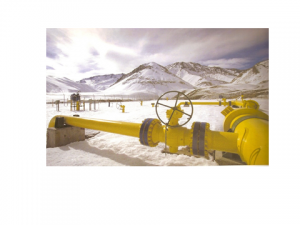The evaluation of oil and gas reserves has been a controversial issue for years as there exist very often considerable uncertainties about the operating conditions of an oil field whose exploitable content is not really known until the end of operations. To evaluate oil and gas reserves, geologists use probabilistic methods, they thus qualify as « proven reserves” those for which there exists a probability amounting to at least 90% that the oil or gas could be extracted from exploited fields profitably with available technology. They also take into account what they call « probable » reserves concerning the discovered fields that have a probability of more than 50% to be exploited. Remaining uncertainty is related to the geology of the fields and to the economic conditions to carry out an oil exploitation project (see Laherrère, J., « The oil and gas prospects, » Futuribles, No. 373, p. 5 April 2011 www.futuribles.com ); geologists add, sometimes, these two categories of reserves. Let recall also that new field discoveries have been rather rare in recent years, the most important one’s were made in Brazil and Mozambique. Finally, we note that despite the rampant economic crisis in Western countries since 2008, global oil consumption has not really slowed down, driven by economic growth in emerging countries such as China.
If we stick to the definition of proven oil reserves, the majority of experts converge on the figure of 1,500 billion barrels (1500 Gbarils) or 230 Gtep oil reserves (world production stood at 86 million barrels / day in 2012 , See BP Statistical review of World Energy 2013, www.bp.com and IEA, World Energy Outlook 2013 www.iea.org ). Those reserves represent about 50 years of demand at its current rate but their assessment raises questions. We must first note that they take into account crude oil, gas condensed and natural gas liquids and oil sands of Canada and of the Orinoco basin in Venezuela (350 Gbarils which are difficult to exploit) but not shale oil. The extraction of these sand oil is difficult as it requires water to separate oil from sand and will probably be expensive (it started in Canada) and will face strong local opposition. Moreover, those figures are disputed by experts who consider them as being too optimistic, we can, in fact, qualify them as « official » as these are communicated by companies and States. Other experts who have combed through technical evaluations of each production region lead to more pessimistic estimates because, according to them, the reserves would not exceed 1000-1200 Gbarils. They have pointed out, in fact, that the OPEC countries have voluntarily inflated their reserve estimates in the 1990s (see in particular Laherrère, J., « The oil and gas prospects, » Futuribles, No. 373, p. 5, April 2011 , www.futuribles.com ) by nearly 300 Gbarils in order to increase their production quotas.
As far as proven natural gas reserves are concerned, according to BP, they would amount to 180,000 billion cubic meters (170 Gtep) and represent approximately 55 years of world demand. Note that these estimates do not take into account gas or oil shale resources (as well as coal bed methane), the assessment of which is for the time controversial, outside the United-States and particularly in Europe. Taking into account the prospects of shale gas, exploitation, the IEA has been showing for several years a strong optimism about the future of gas and, on the basis of mainly U.S. data it is true, it evokes regularly prospects of a « golden age of gas » and it considers that the total combined reserves of unconventional and conventional gas are equivalent to at least a century of demand. However, it is necessary to be cautious even though it is undeniable that the United States have changed the energy international landscape by launching the exploitation of gas and oil shale at a very high rate (see P.Papon » Shale gas, myths and reality”, Futuribles, No 399, p 81, March-April 2014, www.futuribes.com ).
future of gas and, on the basis of mainly U.S. data it is true, it evokes regularly prospects of a « golden age of gas » and it considers that the total combined reserves of unconventional and conventional gas are equivalent to at least a century of demand. However, it is necessary to be cautious even though it is undeniable that the United States have changed the energy international landscape by launching the exploitation of gas and oil shale at a very high rate (see P.Papon » Shale gas, myths and reality”, Futuribles, No 399, p 81, March-April 2014, www.futuribes.com ).
Could there be hidden concealed significant hydrocarbon deposits treasures, particularly in the polar regions? This is the question that is often asked to experts. The Arctic Ocean is a coveted area for the ice thawing which seems to be enhancing due to climate warming (ice cover of the ocean at the end of the summer falling steadily for twenty years) opens the possibility of exploiting potential oil and gas offshore resources. According to the USGS (United States Geological Survey) a quarter of conventional oil world reserves yet to be discovered might be located in this part of the world (80% in off-shore). However, we shall note that except possibly on the margins of continental shelves of coastal countries, no systematic exploration has been conducted. Moreover Arctic space is an area where the claims on the delimitation of EEZ (Exclusive Economic Zones) are at stake and strong rivalry between the five coastal countries (see S.Debruyne, « Some issues of thaw Arctic « Futuribles, No. 400, p. 122, May-June 2014 www.futuribes.com ).
Antarctica is another area farther away, that would possibly attract oil rivalries. The future of the South Pole is rarely addressed by prospective studies, but a recent note from the School of economic warfare in France has emphasized the potential importance of energy issues in Antarctica, the opening by China of its fourth scientific station, Taishan, in February 2014 located on the continent by 2600 m of altitude illustrates this affirmation (see School of economic warfare, Philippe Sambussy, Energy Issues in Antarctica, February 2014, www.infoguerre.fr/matrices- strategic / the-issues-energetic-en-Antarctic / ). This note is based on a prospective report by an Australian institute, the Lowy Institute for International Policy (Lowy Institute for International Policy, Ellie Fogarty, Antarctica : Assessing and Protecting Australia’s Interests, August 2011). Recall that the Antarctic Treaty, signed in 1959 during the Cold War by fifty States, has temporarily « frozen » territorial claims on the region until 2048, which is presently considered as « peace zone » where only scientific research is authorized. Several states are claiming sovereignty over a part of Antarctica (divided into zones centered on the South Pole, for example with France Terre Adélie territory) and this treaty was completed by the Madrid Convention that protects the environment and an additional protocol which prohibits mining activity. The prospect of exploiting the underground resources of Antarctica and of the surrounding seas after 2048 raises speculation and greed. The Australian report finds that « reserves » of oil (on the mainland and offshore in the Weddell and Ross seas continental shelf on territories claimed by Australia and New Zealand) could be as high as 203 billion barrels (the accuracy of this figure is amazing!). They would represent the third largest oil reserves behind only those of Saudi Arabia and Venezuela. No serious evaluation of these resources has been actually performed but a large number of countries as neighboring Australia as well as China and Russia, want to take a stand for the future by conducting « scientific » operations. Russia on her Vostok station (located within the territory claimed by Australia) had performed a scientific drilling in the continental ice at 3800 m depth (to a lake) which gives her a deep drilling experience in ice, and is planning to strengthen its infrastructure with new polar ships and launches a program to investigate the mineral and biological resources of the continent. Maneuvers for the future of Antarctica 2048 horizon has begun and the former French Prime Minister Michel Rocard, Ambassador for the poles, noted in 2013 that « the oil resources are threatening the Treaty. » Indeed, it is possible that advances in drilling techniques and their lowering cost might allow profitable exploitation of oil and minerals. The whole question is whether the signatories of the Antarctic Treaty states will accept the exploitation of the continent’s resources, an alternative being that they would be considered as part of the “heritage” of humanity?
Anyway access to hydrocarbon resources in the polar cold regions will long remain very uncertain and controversial (how in remote areas would it be possible to deal with possible accident similar to that one which occurred in 2010 in the Gulf of Mexico with the Deepwater Horizon platform?). We face a similar problem with methane hydrates resources which we mentioned in our blog (they have been found on the ocean margins and Japan with his lack of energy scored a « first » in 2013, degassing for 6 days a hydrate layer in 2013 by 1000 m deep). One can also ask questions about the oil sands and oil and shale gas (unless we find an alternative to hydraulic fracturing with water, a possibility which should not be excluded). Realism should lead to the conclusion that there are not very likely hidden exploitable hydrocarbon resources by 2050…..
